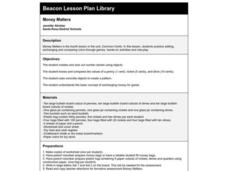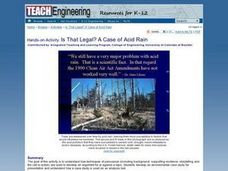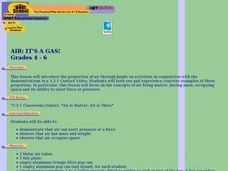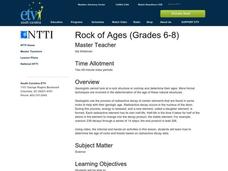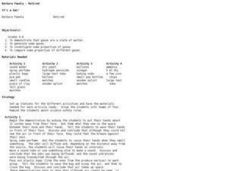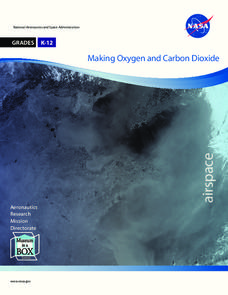Curated OER
Money Matters
Students play a game called Money Matters using cut out representatives of pennies, nickels, and dimes.
Curated OER
An Internet Activity for The Introduction Of The Civil War
Students research, using the Internet, specified Civil War battles in order to prepare an oral presentation for the class. They, in small groups, present using images and maps. They take a quiz on the subject matter and evaluate the web...
Science 4 Inquiry
The Ins and Outs of Photosynthesis
The most important chemical process on Earth is photosynthesis. Scholars explore the changes in the gases in our atmosphere as life on Earth developed. They create a model of photosynthesis and consider simple questions.
Teach Engineering
Measuring Viscosity
Groups use a marble to determine the viscosity of household fluids. The procedure calls for pupils to measure the amount of time it takes a marble to fall a specified distance in the fluids. Using unit conversions and algebra, the teams...
Exploratorium
Balancing Stick
Have some physical science fun when studying the center of gravity or center of mass. Simply have balancing artists stand a dowel on one finger and keep it from falling over! A lump of clay is added and moved up along the dowel over a...
Curated OER
Is That Legal? A Case of Acid Rain
Develop an environmental case study! Elementary learners discover how a case study is used as an analysis tool. The goal of this activity is to show pupils how techniques of persuasion (including background, supporting evidence,...
Melanie Giovannone
Letter-Sound Match Cut and Paste
Develop beginning readers' understanding of letter-sound correspondence with this fun series of cut-and-paste worksheets. With each page focusing on four specific letters, children are able to practice isolating...
Historical Thinking Matters
Social Security: 3 Day Lesson
What does social security reveal about the political and social culture of the 1930s? After beginning with a brief introductory video on the impact of the Great Depression and how various Americans, such as Huey Long and Francis...
Curated OER
Air: It's a Gas!
Students investigate the properties of air through hands-on activities in conjunction with the demonstrations in a 3-2-1 Contact Video.
Curated OER
The Real World Revisited
Class members participate in a series of hands on, online, and multimedia activities to identify the difference between primary and secondary sources. They watch a related video and visit a variety of sites to locate primary and...
Curated OER
Friction: Friend or Foe?
Using a hands-on approach, learners explore the effect of friction on objects. Learners use toy cars, shoes, wood, metal, and more to experiment with the causes and effects of friction. Afterwards, they conduct experiments in which they...
Curated OER
Dig This Dinosaur Relief Lesson
Students create low-fire ceramic relief sculptures of dinosaur bones. They incorporate art history, aesthetics, and criticism with hands on activity. Students work together to draw an enlarged skeleton on butcher paper. The Stegosaurus...
Curated OER
Rock of Ages
Students use a video, the Internet and hands-on activities to explore how to determine the age of rocks and fossils based on radioactive decay data.
Curated OER
It's a Gas!
Students investigate gases and their properties by completing 4 activities. In this gases lesson plan, students perform activities to show that gases take up space, they diffuse, and that odors and vibrations pass through gases. They...
Curated OER
To Float or Not to Float, That is the Question?
Ninth graders develop operational definition of density, do computations using density equation, categorize pieces of matter as being able to float on
water or not, based on density, explain why some objects sink or float based on...
Curated OER
Activity #5 'Empty' Bag?
Students review that air is a form of matter. They investigate how air takes up space. Pupils comprehend that they cannot see air, it takes up space and has mass, therefore it is a form of matter. Students investigate how to show that...
Perkins School for the Blind
Conservation of Mass
How do you teach a student with visual impairments about the conservation of mass? You use tactile models that represent the theoretical concept. Baking soda and vinegar are used to add gas to a deflated balloon. Learners will feel the...
Teach Engineering
Tools and Equipment (Part 1)
Looking for the best inclined plane for the job? Groups calculate the theoretical mechanical advantage for four different inclined planes. They determine the actual mechanical advantage by measuring the amount of force needed for the...
NASA
Making Oxygen and Carbon Dioxide
Some like it hot! Scholars observe both exothermic and endothermic reactions as part of the carbon dioxide oxygen cycle. First, scientists demonstrate (or watch) a chemical reaction to create pure oxygen using fire for...
University of Miami
What is it? Weathering, Erosion, or Deposition?
Just as rocks move through the rock cycle, your giddy geologists will move descriptions around until they are all in the correct category. After cutting out several types of rock movement, learners determine whether the action is...
Curated OER
Black Skin, White Justice: Race Matters in the Criminal Justice System
Young scholars examine the effects of race in the criminal justice system. As a class, they brainstorm a list of instances when the offender has been an African American and he is not treated fairly in court based on his race. They...
Curated OER
Holiday Paper Projects for Kids
No matter what time of year it is, there's a holiday craft to make! Kindergartners construct several holiday craft projects in a series of holiday art lesson. They complete several paper projects such as 4th of July flags,...
Curated OER
Classifying Matter Game
Students identify the different states of matter. In this chemistry lesson, students differentiate the physical properties of the three states. They apply what they learned by playing a team game at the end of the lesson.
Curated OER
Properties of Matter
Second graders investigate how objects can be described, classified and compared by their composition. They recognize that the same material can exist in different states. Students verify that things can be done to materials to change...
